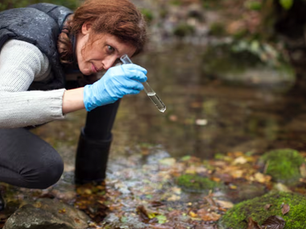
Water Quality Monitoring
CRC’s water quality monitoring program provides vital scientific information to help the public and local, state, and federal partners better understand our rivers’ health. The data collected by our volunteers and staff helps inform other areas of work such as advocacy, restoration, and recreation access.

CRC's Water Quality Monitoring Lab
CRC headquarters in Greenfield is home to a water quality lab where we process water samples for E. coli bacteria, nitrogen, and microplastics for ourselves, our partners, and the watershed community.

Is it Clean Water Quality Database
Water sample results in the watershed are uploaded to the Is it Clean website. Users can get E. coli data and likely water quality conditions to help make decisions about where to safely swim, boat, or recreate in local waterways.
.jpg)
Connecticut River E. coli Report (2019-2023)
Volunteers for CRC collect samples of the Connecticut River weekly from twenty-two locations in Massachusetts, Connecticut, and Vermont. This report combines data from five years, illustrating trends in water quality.

Volunteers for Water Quality
Volunteers from throughout the watershed collect water samples from the Connecticut River and its tributaries during the spring and summer. The samples collected are tested for a variety of parameters, depending on the specific program. The parameters can include E. coli bacteria, nitrogen, phosphorus, chloride, turbidity, specific conductance, and microplastics.
We recruit volunteers annually in early spring. We usually have limited openings and specific geographic needs. If you’d like to sign up to let us know that you’re interested and be among the first to know when we need help, contact Melissa at mlangley - at - ctriver.org. We are also happy to connect you with the local watershed group that samples near you if it isn’t us.
Partnerships in the Watershed
In addition to our own monitoring initiatives, CRC supports our subwatershed groups with their monitoring efforts in a variety of ways. We have helped by providing coordination or other technical assistance, processing samples at our lab, or including them as partners in our grant applications to support our joint monitoring goals. Some of the groups we work with regularly are:
-
Deerfield River Watershed Association
-
Fort River Watershed Association
-
Chicopee 4 Rivers Watershed Council
-
Scantic River Watershed Association
-
Black River Action Team
-
Ottauquechee NRCD

The Connecticut River 's water quality has improved over the past few decades thanks to clean water legislation and the efforts of many conservation organizations, local and state agencies, and volunteers. But pollution, climate change, and obstacles to free-flowing rivers still remain, and require ongoing monitoring to inform the public.
Stormwater & CRC's Lab on NEPM
NEPM's Connecting Point news segment did a fantastic job of covering one of the biggest challenges of pollution in our rivers, which are Combined Sewer Overflows (CSO's). Due to outdated infrastructure, stormwater drains and sewage drains are connected in parts of the central watershed, resulting in sewage overflows into the Connecticut River during times of heavy rains or flooding. This sometimes leads to elevated E. coli and river conditions not considered safe for recreation.
Cyanobacteria Research
Connecticut River Conservancy began a cyanobacteria monitoring program in the summer of 2022, and has continued this work during the 2023 field season. While cyanobacteria does not yet pose a serious threat to the Connecticut River watershed, there have been cases of cyanobacteria blooms which have the potential to become a bigger challenge in the future as climate extremes increase and agricultural nutrients affect water quality.
Our 2023 Cyanobacteria Monitoring Report is now available to provide the data gathered so far from 8 lakes and ponds tested in Massachusetts. In short, 2 of the 8 waterbodies were found to have active cyanobacteria blooms in 2023. This research will continue during the 2024 field season and will have new reporting in the fall of 2024.

Water Quality News
For questions about CRC's water quality monitoring, or to volunteer to collect water samples, contact Melissa at mlangley - at - ctriver.org
or call 413.450.8739.






